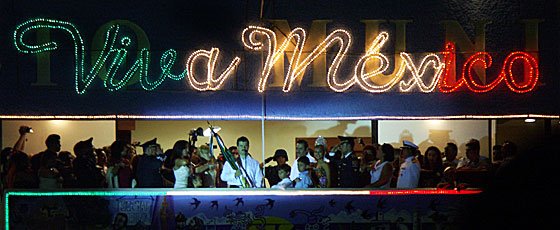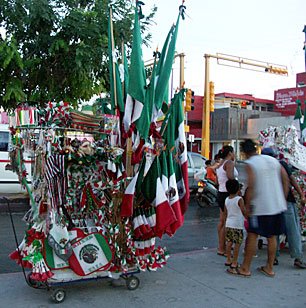Not Cinco de Mayo ...

It is a commonly believed myth, especially in the US, that the biggest fiesta day for Mexicans is Cinco De Mayo. There are also implications that it is their Independence Day. It is not.
I was one of those who fell for this greeting card hype when I arrived in the US and fully expected my workers to disappear on that day for fun and fiesta. As it turns out, Cinco de Mayo is just another of those “Hallmark” days promoted mostly by the US consumer mammoth.
When I asked my guys last year if they would be taking the day off they just mumbled, hmmmm…Cinco de Mayo …” and continued on with what they were doing, courteously not putting me right with a lecture on our cultural differences. I was baffled and being such a screen sucker, went off and read up on the whole thing.
Cinco de Mayo is the commemoration of the battle of Peuebla, 5th May 1862. This was a famous victory for a small, ill equipped Mexican force against the greater manpower and expertise of the French army under Napoleon III. It is a recognized date south of the border, obviously more so in the Peuebla area, but the greater celebrations are reserved for Independence Day.
The evening of the 15th and the 16th September are the actual day/s of the Mexican Independence celebrations. On the evening of the 15th at 11pm prompt, the President delivers the Grito de Dolores. The translation of this phrase has double entendre, it can be translated as either the Cry of Dolores (the city of Dolores) - or the cry of pain and is seen as a decisive moment in the Mexican struggle for their independence. The following day is the day of the fiesta.
The original Grito was delivered 15th September 1810 by Father Miguel Hidalgo y Costilla, a father figure of the struggle and a priest of the town Dolores. To stir the populous into earlier than planned action he rang the church bell and delivered words now referred to as “El Grio” (the cry). "Long live religion! Long live Our Lady of Guadalupe! Long live the Americas and death to the corrupt government!”
The “soup of the day” corrupt government of this era being Spain. After a long struggle Mexico finally won its independence from Spain in 1821 but still remained in debt to other countries who tried to lay claim to territory in leu of payment, hence the the battle of Peuebla.

The Grito is now delivered by city officials from balconies around the country as a sign for the start of festivities. The present day Grito is a less chastising version of the original …listing the heroes of the struggle and cumulating in the stirring cry of “Mexicanos, Viva México” - Mexican’s …long live [our free] Mexico.
Everyone gathers at the zocalos (town meeting place) of cities, towns, and villages for the 11pm delivery of the Grito by their city official. This is followed up by much fireworks fiesta and dancing late into the next day ... assuming it doesnt rain too much. Unfortunately this year it did rain ... but not till after the impressive firework display. My builder later tells me it has rained every night of the 15th Sept for the past 22 years!
 To digress for a momentito. Grito is very similar to the auld Scots word “to greet” (to cry) which is still used regularly in Scotland to this day. Din'e greet hen … don’t cry dear. It’s demonstrated well in “Tam o’Shanter”, a well know poem by the Scottish Bard, Robert Burns.
To digress for a momentito. Grito is very similar to the auld Scots word “to greet” (to cry) which is still used regularly in Scotland to this day. Din'e greet hen … don’t cry dear. It’s demonstrated well in “Tam o’Shanter”, a well know poem by the Scottish Bard, Robert Burns.Ah! gentle dames, it gars me greet,
To think how monie counsels sweet,
How monie lengthene'd, sage advices
The husband frae the wife despises.
The translation for the Scottish language challenged reader goes as follows:
Ah! Good ladies, it makes me cry,
To think how much helpful guidance
How many detailed wise pieces of advice
Are offered by wives but not appreciated by husbands.
It should be mentioned the guy was also a well-known womaniser … one can see from this snippet why he was so successful!

 But to continue,
But to continue,In Cozumel the decorations have been up for some time and the vendors of various trappings of the fiesta have been touring the streets.
Homes and businesses are decorated with flags and red, white and green banners, andt he fair is in town, complete with stalls, kiddie rides, a hair raising, 360 degree spinning, adult ride and animales con deformacions gemeticas (genomically deformed animals).
And in answer to what you’re thinking … no … I left that thrill for another day!


It’s interesting that both situations (and other well known conflicts) arose from the same old same o’. Any parent of a teenager will be familiar with the scenario … young country gets pissed off with older parent county. Then wants to go off and manage their own affairs, rather than be told what to do and fork out well earned dosh without having a say in the matter. Taxation without representation ring any bells?
More wordy references to the whole to-do can be found here.
Wiki - Miguel Hidalgo
The Significance of "Cinco de Mayo"
Wiki - War of Independence
History of Mexican Independence
The Grito
Mexican independence

You can see why the US greeting card industry chose not to focus too much attention on, “Quince y Dieciséis de Septiembre” (kin say ee de ace sigh eez day sep tee em bray… phew!). It doesn’t quite roll off the tongue nor have quite the ring of the nicely rhyming “Cinco de Mayo” (sin-co day ma-yo). And o-one likes to see two dates strewn across a card … (or a sentence start with an “and” for that matter) …very messy.
And speaking of independence fwiw …one Brit at least has reclaimed a piece of Virgina (Ha!) and is now working on same in Mexico …
You just can’t keep a good country down!
Viva México! Go Mexico!
How to avoid screen sucking and manage your life better try this for an interesting read.

0 Comments:
Post a Comment
<< Home